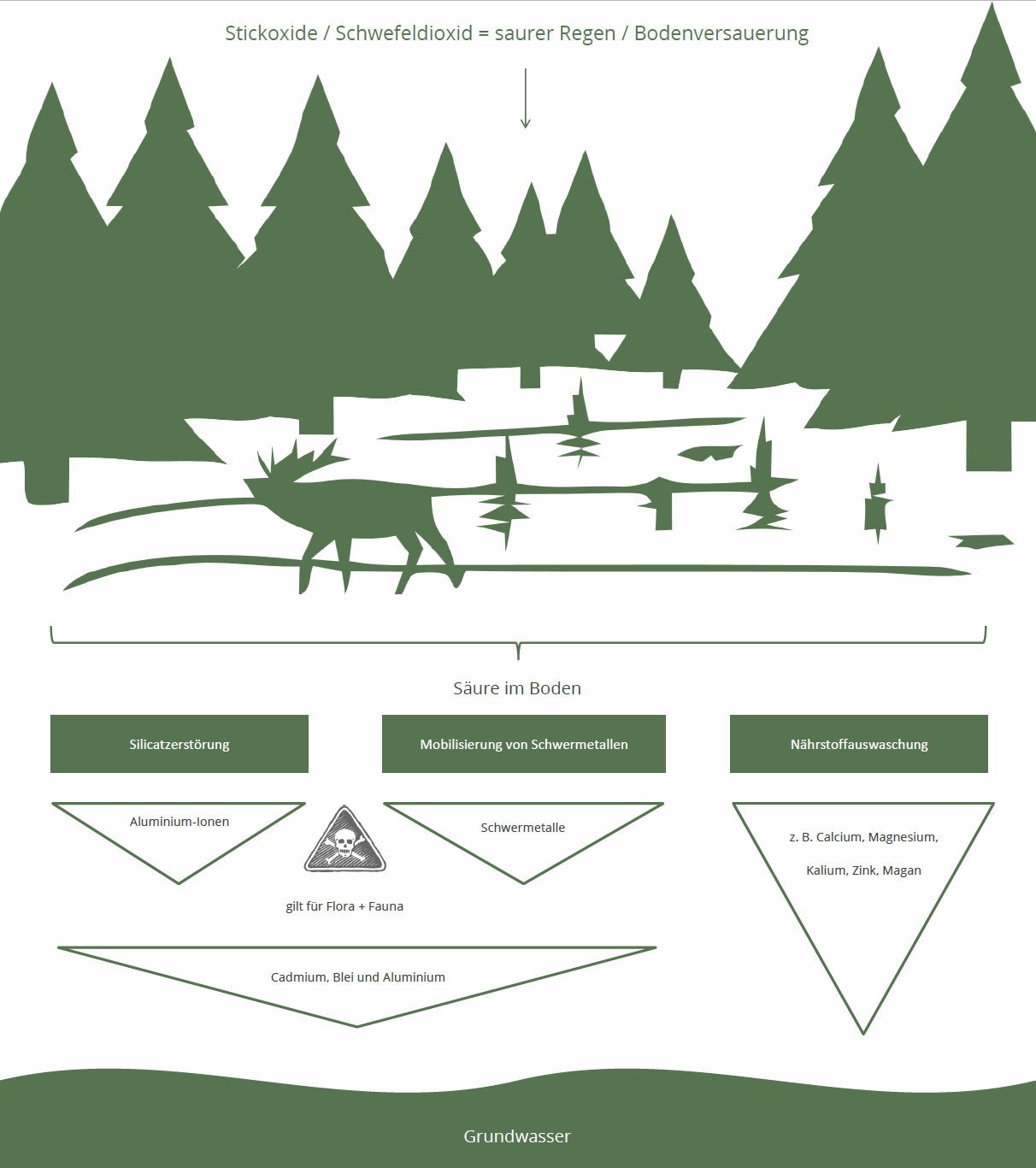[:de]Die Versauerung der Waldböden hat ein beängstigendes Ausmaß angenommen. Schuld sind vor allem Schwefeldioxid- und Stickoxid-Emmissionen. Schwefeldioxid, Stickoxide, Umwandlungsprodukte (Fotoxidantien) greifen Boden und Bäume an. Gegenmaßnahmen, wie Kalkung und Düngung sind unbedingt notwendig, um die Bodenversauerung und ihre Folgeschäden zu verringern. Der Anteil der kranken Bäume in Deutschland liegt heute je nach Region und Baumart zwischen 32 und 76 Prozent. Mehr als 1/3 aller Waldböden weisen bereits Versauerungsschäden auf. Die Folgen und Gefahren der Versauerung zeigt das folgende Schema.

Da sich die Schadstoffbelastung im Waldboden über viele Jahrzehnte angesammelt hat, geht dieser Gesundungsprozess aber nicht von heute auf morgen.
Auf Risiken für Flora und Fauna wird im Rahmen der Bodenschutzkalkung besonders Rücksicht genommen, indem die Kalkausbringung nur außerhalb der Vegetationszeit durchgeführt wird und waldbauliche Aktivitäten, sowie Kalkungsmaßnahmen aufeinander abgestimmt werden. Der für die oberflächen- bzw. laufaktiven Insekten besonders ungünstige Feinanteil (0 – 0,09 mm) wird durch den Einsatz von Granulaten, wie z. B. dem Produkt Wald 80 P3 (mit 3% weicherdigem Rohphosphat) verhindert.
Artikel und Forschungsergebnisse zum Thema „Kalk im Wald“
10 Jahre erfolgreiche Bodenschutzkalkung in den rheinland-pfälzischen Wäldern.
Forschungsanstalt für Waldökologie
und Forstwirtschaft Rheinland-Pfalz
D-67705 Trippstadt
Internet: www.uni-kl.de/FVA/de/index.htm[:en]The acid part of the forest grounds accepted a frightening scale. Emissions are guilty before all sulphur dioxide and embroidering-oxide. Sulphur dioxide, nitrogen oxides, transformation products attack ground and trees. Countermeasures, as lime and fertilising are absolutely necessary in order to reduce acidity and their consequential damages. The part of the ill trees in Germany lies today according to region and tree species between 32 and 76 percent. More than 1/3 of all forest grounds already show damages.
The following scheme shows the consequences and dangers.

Since the pollution burden was collected in the forest ground over many decades, this recovery process does not go, however, from one day to the next.
Onto risks for flora and fauna especially regard is taken within the framework of the lime dispersion, when the lime is scattered only outside of the vegetation time and silvicultural activities, as soon as lime measures are synchronised with each other. That for the surface and/or race-active insects especially unfavourable detailed part (0 – 0,09 mm) becomes through the use of granular materials, as for example the product Wald 80 P3 (with 3% soft-earthy raw phosphate) prevents.
Articles and research results on the topic „Kalk im Wald“
10 years of successful lime dispersion in the Rhineland-Palatinate forests.
Forschungsanstalt für Waldökologie
und Forstwirtschaft Rheinland-Pfalz
D-67705 Trippstadt
Internet: www.uni-kl.de/FVA/de/index.htm[:]
